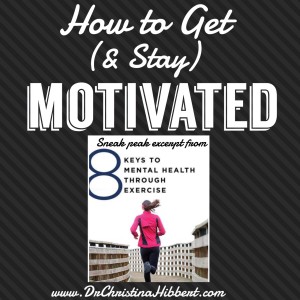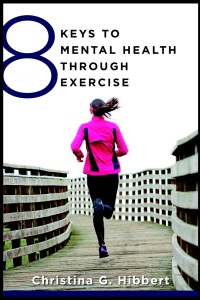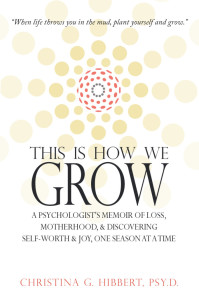21 Jan How to Get (& Stay) Motivated! (Sneak Peak Excerpt from my new book, “8 Keys to Mental Health Through Exercise”)

It’s late January and there’s no better time to talk about motivation. We may have set goals, resolutions, and themes, but are we still going strong? Or is motivation starting to wane?
I’ve been counting the days ’til the release of my new book, “8 Keys To Mental Health Through Exercise,” but in the meantime, I thought I’d give you a sneak peak, sharing some of “Key 4: Get Motivated!” Though written for those trying to get and stay motivated to exercise, you will see you can apply these strategies to any goal you’re trying to achieve. Be sure to do the exercises at the end, too! It’s a sure way to start feeling more motivated today. And check out 8 Keys to Mental Health Through Exercise—SAVE 25% plus free shipping, with the code HIBBERT, on Norton.com or find it on Amazon or Barnes & Noble!
“Strength does not come from physical capacity. It comes from an indomitable will.”
—Mahatma Gandhi
“What is Motivation?’
“We can all relate to feeling motivated by something, or unmotivated, can’t we? The first example that comes to mind is school and homework. I’m sure each of us can recall a time from school or college days when we needed to complete a paper, project, or studying, but we just didn’t feel motivated to do it. Perhaps we were able to make ourselves get up and do it anyway, but perhaps we procrastinated and paid the price later. Either way, we know what motivation, or lack of motivation, feels like. What we may not fully understand is what motivation really is and how it really works.’
“Motivation is a psychological construct used to explain behavior. It also helps us understand our desires, needs, wants, thoughts, and feelings. It’s what gets us up and doing what we know we could, should, or need to do. It’s what makes us want to change, grow, and improve. It explains why we want to repeat or to stop a behavior, and also helps us understand why we don’t act—why we avoid, reject, or even fear certain behaviors, feelings, and experiences. Motivation is a word that’s part of our daily thought processes and vocabulary, and it’s one of the most popular concepts that we’ve adapted from psychology into everyday life. Motivation is quite literally in everything we do (or don’t do).’
“Unfortunately, for the most part, we don’t understand or comprehend our own motivations. This is where so many of us get stuck. We know when we feel motivated. We know when we don’t feel motivated. But how regularly do we check in, evaluate, and try to understand our motivations—our motivations for how we treat people, why we do the things we do, what we avoid, and yes, our motivations for our daily behaviors, including exercise? For most of us, I’d say, it’s pretty infrequent. The truth is we don’t always know why we do what we do, and until we can understand our motivation, we’ll continually struggle to get to where we want to be. Let’s do an exercise to help illustrate what I mean. Please grab a pencil, find a quiet spot, and take a few moments to honestly ask yourself the following questions.’
“Reflection Questions: Self-Motivations”
“1. Why did I [decide to read this article] in the first place? What motivated me to [click on the link]?
2. Once I [clicked on the article,] what motivated me to [actually] start [and keep] reading?
3. …What do I hope to gain from reading this?
“Did you answer the reflection questions? If so, what motivated you to take the time to do this exercise? Was it because I asked nicely? (I did say, ‘please.’) If you did not answer the reflection questions, then what motivated you to skip it?’
“See? Motivation is in everything that we do (or don’t do), and when we begin to examine our motivations, we begin to find the key to initiative, drive, follow through, and ultimately, to achieving what we most desire.”
…
“How Does Motivation Work: Theory and Understanding”
“In order to understand our own motivations to implement and continue an exercise for mental health  program, it’s helpful to learn a little more about motivational theory and how motivation really works. There are numerous motivation theories (I recall taking a “Theories of Motivation” class in college that was three hours per week and lasted four months). This is not a book about motivation, and so we will not examine all the motivational theories. Instead, we will focus on three theories that, according to research, and in my opinion, are the most helpful when it comes to motivation in physical activity and exercise, especially exercise for mental health.”
program, it’s helpful to learn a little more about motivational theory and how motivation really works. There are numerous motivation theories (I recall taking a “Theories of Motivation” class in college that was three hours per week and lasted four months). This is not a book about motivation, and so we will not examine all the motivational theories. Instead, we will focus on three theories that, according to research, and in my opinion, are the most helpful when it comes to motivation in physical activity and exercise, especially exercise for mental health.”
“Self-Determination Theory”
“One of the most well-studied and validated motivational theories, when it comes to exercise, is called self-determination theory (SDT). Originally developed after years of research by Edward Deci and Richard Ryan, self-determination theory grew from a humanistic perspective, meaning that, similar to Abraham Maslow’s Hierarchy of Needs (another, well-known theory of motivation) SDT focuses on the fulfillment of human needs, self-actualization, and how we can realize our potential as human beings (Teixeira et al., 2012). In short, self-determination theory posits that we are most motivated when our motivation comes from within—when we are self-motivated and self-determined.’
“Some of the key elements of self-determination include the following:’
“Intrinsic and Extrinsic Motivation”
“First, SDT differentiates between intrinsic and extrinsic motivation. Intrinsic motivation means doing something because we enjoy, are excited about, appreciate the challenge of, feel accomplished at, and/or like putting our skills to use in a given activity. Examples of intrinsic motivation include someone who swims because she is talented and accomplished at it, someone who dances because he just loves to dance, or someone who enjoys the satisfaction she feels after rising to the challenge of a difficult workout. Each of these intrinsic motivators makes the activity itself worth doing, for different reasons but all of them internal and related directly to the activity.’
“On the flip side, extrinsic motivation refers to doing an activity to gain some form of outside reward. It involves a separate gain from that achieved by doing the activity for the activity’s sake. For example, we may exercise to gain the approval or acceptance of others, earn a tangible reward like money or a treat when we’re done, or because, if we don’t participate, say, in a school physical education class, we’ll get a bad grade. Extrinsic motivation can also involve our values and goals, such as someone who is motivated to exercise because he values becoming more muscular to feel better about his physical appearance (Ryan & Deci, 2000;Teixeira et al., 2012).’
“The best motivators for short-term activity are extrinsic motivators, but for long-term commitment, intrinsic motivation is key. Thus, we need to develop both if we want the optimal motivation to exercise for mental health [or to accomplish any other goals we’ve set for ourselves].”
“Causality Orientations”
Another element of self-determination theory, which goes along with internal and external motivation, is called “causality orientations”—a fancy term for the idea that we each have specific dispositional tendencies
when it comes to motivation. These tendencies can impact our motivation to exercise, and keep at it. Some of us are more internally oriented and more likely to follow our own thoughts, feelings, and courses of action. Others are more externally oriented, meaning they are more likely to follow external norms, advice, and directives. And some are generally “amotivated,” meaning they’re more likely to be unresponsive or passive to external or internal factors that might motivate their behavior (Teixeira et al., 2012). These differing orientations impact our beliefs, motivations, and practices of exercise for mental health (Markland, 2009). However, just because we have a tendency to act a certain way doesn’t mean that we’ll always act that way. Understanding our “causal orientation” simply provides an invitation to be more self-aware about what might, or might not, drive and motive us. Remember what we learned about practicing self-awareness [read this post]? It can help us become more self-accepting, self-loving, and ultimately, can increase our sense of self-worth. We can then use this awareness to find ways to overcome or improve our motivational tendencies when they don’t seem to be working well enough. (Review The Pyramid of Self-Worth…for more on how practicing self-awareness can improve self-worth, and thus internal motivation.)”
“Basic Psychological Needs”
“The third element of self-determination theory that’s useful when we’re talking about exercise motivation is the human need for: competence, relatedness, and autonomy (Ryan & Deci, 2000; Teixeira et al., 2012). We’ve already seen how feeling competent in activity is a huge predictor of sticking with an activity—for children, teens, and adults. Additionally, we’ve discussed how social interaction and connectedness are strong motivators for, as well as benefits of, exercise. When we talk about autonomy, we mean that people like doing what they like to do. When we enjoy the activity or feel some intrinsic reward for doing it, we’re more likely to feel motivated to start and stick with it. All three of these basic human needs combine to influence our exercise motivation, for better or worse. When we can identify our competence, relatedness, and autonomy needs concerning exercise for mental health, we can find ways to better meet those needs, thus improving our motivation.”
“Three Premises of Self-Determination Theory”
“Finally, self-determination theory is based on three premises, and these premises play an important role in exercise motivation. First is the premise that we humans are inherently proactive about seeking to master our internal world. This means we tend to work on developing and conquering our drives, thoughts, and emotions. This is a good thing when it comes to exercise for mental health, because if we want to master our internal world, then we’re more likely to prioritize our mental health, and consequently, the strategies needed to “master” it, including exercise. Second, we tend toward growth, development, and integration. This means our natural tendency as humans is to want to improve and be whole. Third, however, is the premise that, though we may seek to master our internal world and inherently tend toward optimal actions and development, they don’t happen automatically. We have to work at it (Ryan & Deci, 2000).’
“That’s what this book is all about—working on new ways to master your internal world, or mental health, and seek the optional actions, like exercise, that will get you to your optimal development. The activity below, and others in this book, can show you how…”
“Reflection Questions:”
“Self-Determination Theory and You”
“1. What is your “causal orientation,” or your natural dispositional tendency, when it comes to exercise [or whatever your current goals may be]? Are you more motivated by internal factors, like your own thoughts, beliefs, and feelings about exercise? Are you more motivated by external factors, like social interaction, accountability, and rewards? Or, are you more in the category of “amotivated”—more passive or unmoved by either internal or external rewards?
2. How does your orientation impact your desire, motivation, and actions to engage in physical activity [or to actively work on your goals, resolutions, or theme]?
3. How important are competence, enjoyment, and autonomy to you, in your life? How important are they in motivating you to exercise [or to achieve your goals]? Write about each of these.
4. What are your thoughts on the “three premises of self-determination theory,” above? Do you believe you’re “inherently proactive” when it comes to mastering your internal world—your mental health, emotions, drives, desires, feelings, thoughts, and behaviors? Why or why not?
5. Do you feel naturally drawn toward growth and integration or is this more of a struggle for you? Why or why not?
6. Do you agree that these things don’t just happen without hard work? Are you willing to do the work you need to do? Why or why not?”
-Excerpted and adapted from key 4 of my brand new book, “8 Keys to Mental Health Through Exercise.” Coming April 2016, and available for pre-order TODAY on Norton.com (save 25% plus free shipping with code HIBBERT) on Amazon & Barnes & Noble! Watch for more sneak peak excerpts, coming soon!
My NEW book is almost here! “8 Keys to Mental Health Through Exercise“
Pre-Order on Norton.com and SAVE 25% plus free shipping, with the code HIBBERT,
or order on Amazon or Barnes & Noble!
Be sure to check out my bestselling, award-winning memoir, This is How We Grow!
Available at Amazon or Barnes & Noble!
My latest book, “Who Am I Without You,” is available now at
Target, Amazon, Barnes & Noble, New Harbinger, or your local bookseller!
Join my “This is How We Grow” 30-Day Personal Growth Plan!
Listen to my episode of “Motherhood” radio, “How to ‘Choose to Grow’ & Make Lasting Change,” for more tips on motivation! Listen on demand/download the episode at WebTalkRadio.net, and/or visit iTunes to subscribe.
Let’s Connect!
SUBSCRIBE, above, “Like” me on Facebook Dr. Christina Hibbert; This Is How We Grow, & follow me on Twitter, Pinterest, & Instagram!
Related Posts/Articles:
New Year, New You! Top 6 Strategies for Personal Growth & Change
“This is How We Grow” 30-Day Personal Growth Plan–My New Year’s Gift to You!
New Year’s Goal-Setting: 5 Steps for Personal Growth Success
Becoming the Butterfly: The Power of Personal Transformation
Beyond Resolutions: Discover your New Year’s Vision
What I’ve Learned about Personal Growth from a Decade of New Year’s Themes
Get Mentally & Physically FITT: How to create an exercise program that Works!
6 Strategies for Mind-Body Wellness & Empowerment
Personal Growth & Self-Actualization
10 Ways I “Choose to Grow” Each Day
Living a Life of Purpose & Meaning: The Key to True Happiness
Parenting Skills Top 10: #1 Do Your Own “Work” First
End of Year Family Awards Celebrates Kids’ Accomplishments!
Stress Management: 15 Proven Ways to Stress Less & Smile More
Slow Down & See: How to Appreciate the Richness of Life
Be of Good Cheer: 12 Ways to Be More Cheerful
50 ways to Love your Loved Ones
Restful Nights & Joyful Mornings? Dream Yourself to Sleep!
Join my “This is How We Grow” Personal Growth Group! FREE. Online. Growth.
10 Ways I “Choose to Grow” Each Day
The Mind-Body-Spirit Connection
15 Proven Ways to Stress Less (& Smile More)
Create the Life You Desire: Part 2, The 3 Steps of Creating
Practicing Patience: 20 Ways to Be More Patient Today
“This Is How We Grow” Blog Hop: 10 Ways I Choose to Grow Each Day






